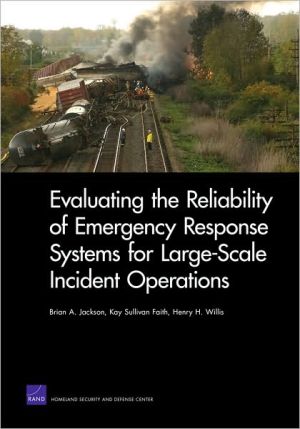

 |

|

Sold Out
Book Categories |
Preface iii
Figures ix
Tables xi
Summary xiii
Acknowledgments xxi
Abbreviations xxiii
Chapter 1 Introduction: Measurement and Emergency Preparedness 1
Public Expectations and Our (Imperfect) Ability to Measure Emergency Preparedness 2
Response Reliability as a Different Approach to Preparedness Assessment 4
About This Study and This Document 7
Chapter 2 Defining and Demonstrating Response Reliability Analysis 9
Defining the Analytical Process for Response Reliability Assessment 9
Component and System Reliability Analysis: An Overview 10
Adapting Reliability Analysis Techniques to the Evaluation of Emergency Response Systems 12
A Simplified Response Example for Defining and Illustrating Response Reliability 20
Step 1 Define and Map the System 23
Step 2 Identify Failure Modes 25
Step 3 Assess the Probability of Occurrence of Different Failure Modes 26
Step 4 Assess the Failure Mode Effects and Their Severity 29
Exploring Quantitative Representations of Response System Reliability 31
Response Reliability Measures Applied to Preparedness Policy Problems 41
Prioritizing Possible Preparedness Investments 44
Making Trade-Offs Between Actions to Improve Performance for Large-Scale Incidents Versus Smaller-Scale, More Common Events 44
Comparing the Cost-Effectiveness of Different Preparedness Improvement Options 45
How Much Preparedness-and Response Reliability-Is Enough? 49
Chapter 3 Describing a Chlorine Release Scenario and Relevant Response Parameters 51
Describing a Chlorine Release Scenario 52
Considering the Capabilities and Requirements for Responding to a Chlorine Release 53
Chapter 4 A Simplified Model of an Emergency Response to a Chlorine Release 59
Top-Level Structure of Our Model of a Chlorine Response 60
Detailed Discussion of Two Exemplary Model Components 63
System-Level Incident Management 65
Response to Victims' Needs 70
Discussion 74
Chapter 5 Exploring What Can Go Wrong During a Chlorine Response Operation: Identifying Relevant Failure Modes 75
Building a Failure Tree for a Response Operation 77
Overview of Our Chlorine Response Failure Trees 80
Detailed Discussion of Two Exemplary Failure Trees 82
Establish and Operate Emergency Operations Center 83
Medical Treatment and Transport 85
Discussion 87
Chapter 6 Assessing the Probability, Effects, and Severity of Failure Modes: An Exploratory Analysis Using Response After-Action Reports 95
Exploring Failure Modes' Probability of Occurrence 97
Description of the After-Action Report Dataset 97
Data Analysis 100
Results 102
Discussion 105
Exploring Failure Modes' Effects and Severity 107
Response Interdependencies and Failure Consequences 108
Considering Individual Failure Effects and Severity in Our Chlorine Response Analysis 108
Looking at Effects and Potential Severity in One Response Case Study 110
Discussion 116
Chapter 7 Concluding Observations 119
Appendixes
A Approximating Response Reliability Curves 123
B Correspondence Between the Chlorine Response Model Used in This Analysis and Other Ways of Categorizing or Organizing Response Operations 129
C Description of Components of the RAND Chlorine Response Model Not Covered in the Text 133
D Failure Trees for All Elements of the Response Model 149
E Counts of Failure Modes Identified per Analyzed After-Action Report 185
F List of After-Action Reports Reviewed and Analyzed 187
Bibliography 193
Login|Complaints|Blog|Games|Digital Media|Souls|Obituary|Contact Us|FAQ
CAN'T FIND WHAT YOU'RE LOOKING FOR? CLICK HERE!!! X
 You must be logged in to add to WishlistX
 This item is in your Wish ListX
 This item is in your CollectionEvaluating the Reliability of Emergency Response Systems for Large-Scale Incident Operations
X
 This Item is in Your InventoryEvaluating the Reliability of Emergency Response Systems for Large-Scale Incident Operations
X
 You must be logged in to review the productsX
 X
 X

Add Evaluating the Reliability of Emergency Response Systems for Large-Scale Incident Operations, The ability to measure emergency preparedness-to predict the likely performance of emergency response systems in future events-is critical for policy analysis in homeland security. Yet it remains difficult to know how prepared a response system is to deal, Evaluating the Reliability of Emergency Response Systems for Large-Scale Incident Operations to the inventory that you are selling on WonderClubX
 X

Add Evaluating the Reliability of Emergency Response Systems for Large-Scale Incident Operations, The ability to measure emergency preparedness-to predict the likely performance of emergency response systems in future events-is critical for policy analysis in homeland security. Yet it remains difficult to know how prepared a response system is to deal, Evaluating the Reliability of Emergency Response Systems for Large-Scale Incident Operations to your collection on WonderClub |